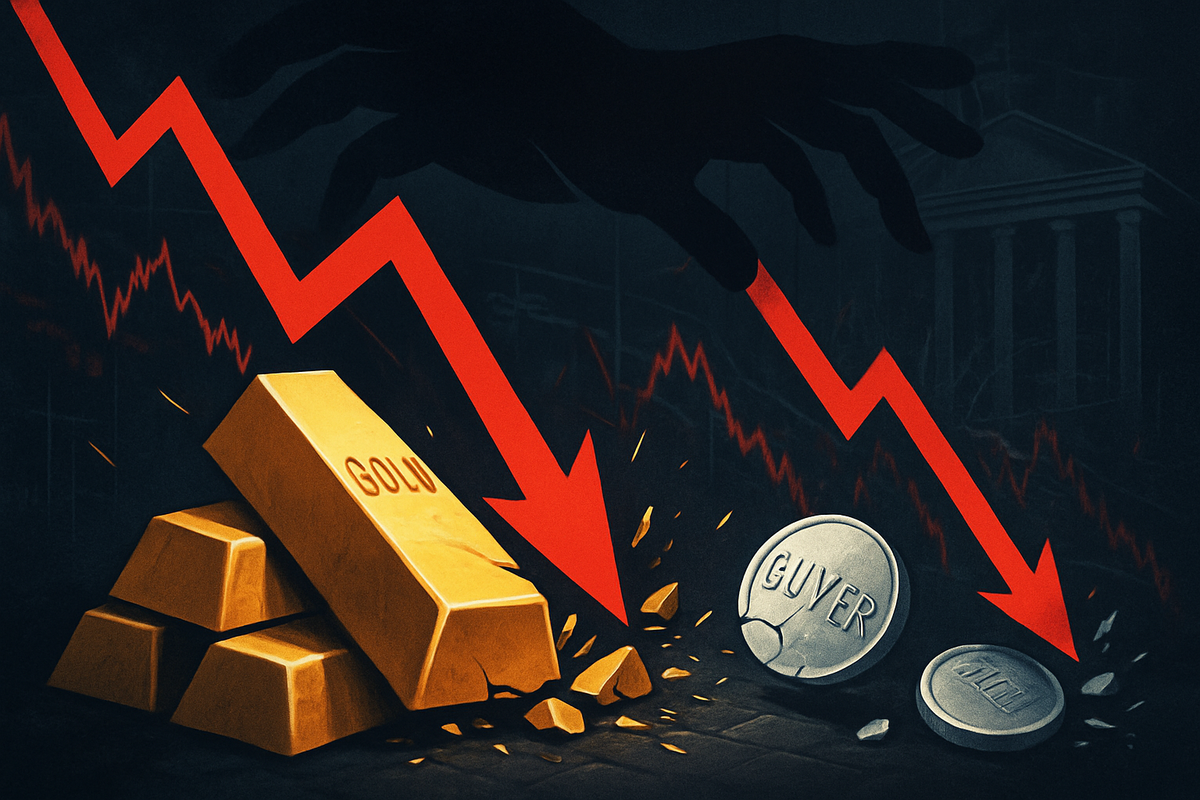
NEW YORK, NY – October 22, 2025 – The precious metals market was rocked this week as gold and silver experienced a dramatic and sudden collapse, wiping out a significant portion of their recent gains. On October 21st, gold suffered its largest single-day percentage decline in over a decade, plummeting by as much as 6.3%, while silver saw an even more precipitous drop of up to 8.7%, marking its steepest one-day fall since 2021. This sharp correction has sent shockwaves through the financial world, reigniting a long-standing and controversial debate: are powerful bullion banks orchestrating these moves to manipulate prices?
The immediate aftermath of the crash has been characterized by intense speculation, with many market participants pointing to the unusual ferocity and timing of the sell-off. While initial analyses cite conventional market forces such as profit-taking, a strengthening U.S. dollar, and a perceived reduction in safe-haven demand, the historical shadow of alleged manipulation by major financial institutions looms large over the current volatility. This article delves into the recent market chaos, exploring both the conventional explanations and the persistent, often explosive, claims of bullion bank interference.
The Sudden Sell-Off: Unpacking the October 2025 Precious Metals Crash
The recent downturn in gold and silver prices on October 21-22, 2025, represents a significant turning point after a period of robust growth. Both metals had enjoyed a spectacular run throughout 2024 and the first three quarters of 2025, with gold nearing an unprecedented $4,400 per ounce and silver exceeding $54 per ounce just weeks prior to the crash. This meteoric rise was fueled by a confluence of factors, including persistent inflation concerns, geopolitical uncertainties, and strong investor demand for tangible assets. However, the gains proved unsustainable in the face of a sudden and aggressive selling spree.
Initial market reactions attributed the sharp decline to several converging factors. Analysts pointed to widespread profit-taking after weeks of scorching rallies, suggesting that technical indicators for both metals were heavily overbought and a correction was inevitable. A notable strengthening of the U.S. dollar also made dollar-denominated precious metals more expensive for international buyers, further exacerbating selling pressure. Additionally, a perceived cooling of safe-haven demand, possibly linked to renewed optimism regarding US-China trade talks and the potential resolution of a US government shutdown, contributed to the exodus from precious metals. The conclusion of India's peak gold-buying season was also cited as a factor in the overall demand decline.
However, for many in the precious metals community, these conventional explanations only tell part of the story. The abruptness and scale of the sell-off, particularly during periods of low liquidity, have once again brought to the forefront long-standing allegations of market manipulation by major bullion banks. While no direct evidence has immediately surfaced linking bullion banks to specific manipulative actions in this particular October 2025 crash, the claims are rooted in a history of documented misconduct and the perceived outsized influence of a few powerful institutions in the derivatives markets.
Arguments for manipulation often highlight historical precedents, such as JPMorgan Chase (NYSE: JPM) paying a record $920 million settlement in 2020 for "systematic spoofing activities" in precious metals and Treasury markets. Similarly, Deutsche Bank settled a class-action lawsuit for silver price manipulation in 2016, providing evidence against other financial institutions. These cases underscore that such practices have occurred. Furthermore, critics point to the significant concentration of open interest in silver futures on COMEX, where a small number of U.S. banks, including Bank of America (NYSE: BAC), JPMorgan Chase (NYSE: JPM), Citigroup (NYSE: C), HSBC (NYSE: HSBC), and Wells Fargo (NYSE: WFC), reportedly control a large portion, fueling concerns about their ability to influence prices. The concept of "synthetic trades" and heavily leveraged positions in the derivatives market, allegedly used to suppress prices, also forms a core part of the manipulation narrative. Conversely, those who argue against manipulation emphasize that bullion banks often engage in legitimate activities like hedging client positions and providing market liquidity, and that their large positions are not inherently indicative of a bearish market view or illicit activity. They contend that market forces, economic fundamentals, and technical analysis are often sufficient to explain price movements.
Corporate Fortunes: Winners and Losers in the Volatile Precious Metals Market
The recent collapse in gold and silver prices will undoubtedly create a ripple effect across various public companies, leading to both significant challenges and potential opportunities. Unsurprisingly, the most immediate and substantial impact will be felt by gold and silver mining companies. Major players like Barrick Gold (NYSE: GOLD), Newmont (NYSE: NEM), and Wheaton Precious Metals (NYSE: WPM) will likely see their revenues and profitability come under severe pressure. Lower commodity prices directly translate to reduced margins, impacting their ability to fund exploration, develop new projects, and maintain existing operations. Share prices of these companies are already reflecting the downturn, and further sustained price weakness could lead to production cuts, project delays, and even asset write-downs. Investors in these companies face significant headwinds, and their long-term growth prospects will be heavily tied to a rebound in precious metals.
On the other side of the equation, the bullion banks themselves, which are at the center of the manipulation claims, could be perceived as potential "winners" if the allegations hold true and they profited from large short positions ahead of the crash. However, this comes with immense reputational risk and the potential for severe regulatory scrutiny and financial penalties if any wrongdoing is proven. Even without direct manipulation, these large financial institutions, through their extensive trading desks and market-making activities, are often well-positioned to navigate and even profit from increased market volatility. Their ability to manage large derivative books and hedge positions allows them to potentially mitigate losses or capitalize on price swings.
Beyond the immediate players, industrial users of precious metals might see some relief. Companies in the electronics, jewelry, and automotive sectors that utilize gold and silver as raw materials could benefit from lower input costs, potentially boosting their profit margins. However, this benefit might be offset by broader economic uncertainties that often accompany sharp market movements. For investors, the crash presents a double-edged sword: those caught on the wrong side of the market face substantial losses, while long-term investors with a strong belief in precious metals might view the current low prices as a significant buying opportunity, betting on a future recovery.
Broader Implications: Market Trends, Regulation, and Historical Echoes
The recent gold and silver collapse, whether driven by fundamental forces or alleged manipulation, fits into a broader narrative of increasing volatility and uncertainty in global financial markets. It underscores the ongoing debate about the true nature of price discovery in commodity markets, particularly those with significant derivative components. The event could intensify the scrutiny on broader industry trends, such as the role of central bank policies, inflation expectations, and geopolitical stability, which have historically influenced demand for safe-haven assets. A sustained downturn in precious metals could signal a shift in investor sentiment away from inflation hedges, potentially impacting other commodity markets and even equity valuations.
The most significant ripple effect could be on regulatory bodies and policy-makers. Given the historical settlements involving major banks like JPMorgan Chase (NYSE: JPM) and Deutsche Bank, this latest episode is likely to trigger renewed calls for increased transparency and stricter oversight in the precious metals derivatives markets. The Commodity Futures Trading Commission (CFTC) in the U.S. and the Financial Conduct Authority (FCA) in the UK, among others, could face pressure to launch new investigations into trading activities surrounding the October 2025 crash. The potential for policy implications includes tighter position limits, enhanced reporting requirements for large traders, or even a re-evaluation of market structures to reduce the perceived influence of a few dominant players.
Historically, allegations of market manipulation in precious metals are not new. Beyond the recent legal precedents, the market has seen numerous periods of intense debate surrounding price action, often coinciding with significant price movements. Comparisons are frequently drawn to past "smash downs" where prices plummeted despite strong fundamental indicators, fueling suspicions among those who believe the market is not truly free. This current event serves as a stark reminder of these historical precedents, reinforcing the skepticism held by many regarding the integrity of the precious metals pricing mechanism. The controversy itself can erode investor confidence, leading to reduced participation or a shift towards physical metal holdings outside the traditional exchange-traded markets.
What Comes Next: Navigating the Aftermath and Future Outlook
The immediate future for gold and silver is likely to be characterized by continued volatility and price discovery. In the short term, market participants will be closely watching for signs of stabilization or further declines. Technical analysts will be scrutinizing support and resistance levels, while fundamental investors will be assessing the underlying economic data, including inflation reports, interest rate decisions by central banks, and geopolitical developments. A sustained period of lower prices could lead to a shake-out in the mining sector, with less efficient producers struggling to remain viable.
In the long term, the debate surrounding market manipulation will likely persist, potentially leading to calls for more radical changes in market structure or increased scrutiny on the relationship between physical and paper precious metals markets. Should the allegations gain further traction or if regulatory investigations yield new evidence, it could fundamentally alter how precious metals are traded and perceived. Conversely, if the market stabilizes and recovers without any conclusive evidence of wrongdoing, the event might be dismissed as a natural, albeit sharp, market correction.
For mining companies, strategic pivots and adaptations will be crucial. This could involve aggressive cost-cutting measures, re-evaluating capital expenditure plans, or focusing on high-grade deposits to maintain profitability. Some might explore increased hedging strategies to lock in future prices, while others might seek consolidation opportunities. For investors, the current environment presents both market opportunities and challenges. The sharp decline could be seen as a rare buying opportunity for those with a long-term bullish outlook on precious metals, especially if they believe the current prices are artificially suppressed. However, the increased uncertainty and potential for further downside represent significant challenges, requiring careful risk management and a diversified portfolio approach. Potential scenarios range from a rapid rebound driven by renewed safe-haven demand or a weakening dollar, to a prolonged bear market if economic conditions stabilize and inflation fears subside, or if regulatory actions permanently alter market dynamics.
Comprehensive Wrap-Up: Assessing the Impact and Moving Forward
The recent sharp collapse in gold and silver prices on October 21-22, 2025, serves as a powerful reminder of the inherent volatility and complex dynamics within the precious metals market. While conventional explanations like profit-taking, a stronger U.S. dollar, and waning safe-haven demand offer a partial understanding of the immediate downturn, the event has undeniably reignited the contentious debate surrounding bullion bank market manipulation. This ongoing controversy, fueled by historical legal settlements and the concentrated influence of a few major financial institutions in the derivatives market, adds a layer of skepticism and intrigue to every significant price movement.
Moving forward, the market faces a period of heightened uncertainty. The immediate challenge for mining companies will be to adapt to a lower price environment, while investors will grapple with assessing the true value of gold and silver amidst conflicting narratives. The long-term significance of this event will hinge on whether it prompts concrete regulatory action, leading to greater transparency and accountability in the precious metals market, or if it simply becomes another chapter in the cyclical and often controversial history of these ancient assets. The resilience of physical demand, particularly from Eastern markets, will be a key factor in challenging any perceived suppression in the paper markets.
Investors should watch for several key indicators in the coming months: any new regulatory probes or statements from bodies like the CFTC, trends in physical gold and silver demand versus speculative futures trading, and broader macroeconomic developments such as inflation rates, central bank monetary policies, and geopolitical stability. The interplay of these factors will ultimately determine the trajectory of gold and silver prices and whether the claims of manipulation continue to overshadow legitimate market forces.
This content is intended for informational purposes only and is not financial advice







